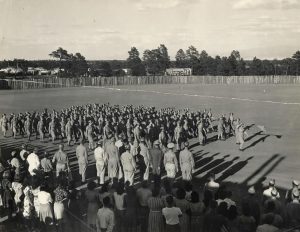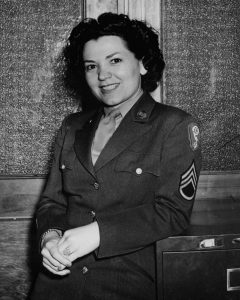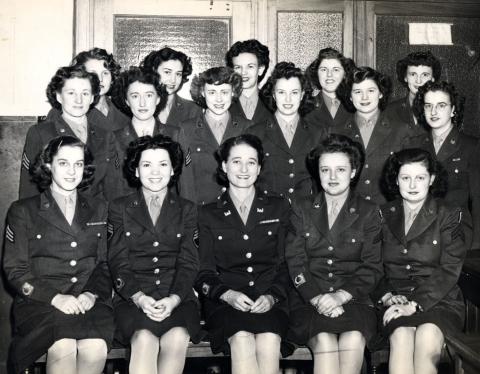The Women’s Army Corps (WAC) was the women’s branch of the U.S. Army. In May 1941, U.S. Representative Edith Nourse Rogers proposed a bill for the creation of the Women’s Army Auxiliary Corps to help with the war effort. On May 14, 1942, Congress approved the creation of WAAC, and the next day President Franklin D. Roosevelt signed the bill into law. The surprise attack on Pearl Harbor motivated this decision. WAAC was established “for the purpose of making available to the national defense the knowledge, skill, and special training of women of the nation.” On July 1, 1943, WAAC was given active duty status, becoming WAC.
Nearly 150,000 American women served in the Women’s Army Corps during World War II. Many of these women served throughout the world with the Army Ground Forces, the Army Service Forces, and the Army Air Forces, in a variety of supporting, non-combat roles. The majority of WACs served with the Army Service Forces.
Over 400 WACs served in the Manhattan District, primarily at the three major sites: Los Alamos, Oak Ridge, and Hanford. Hanford had the smallest group of WACs, and Los Alamos had the largest group. A few were also employed at office sites in New York, Washington D.C., and Chicago. The first detachments of the WAC were sent to project sites in 1943. Frances W. House served as the first commanding officer of the WAC detachments in the Manhattan District. She was succeeded by Arlene G. Scheidenhelm.
Job Assignments
WACs stationed within the Manhattan District worked in a variety of positions. The majority of WACs helped with clerical and administrative responsibilities. They worked as cryptographers, lab technicians, nurses, clerks, secretaries, photographers, metallurgists, and handled classified information. The Provisional Engineer Detachment sought out WACs to help with administrative and secretarial work. Jane M. Amenta, for example, worked as the personal secretary to W.B. Parsons in Oak Ridge, and later as the secretary for Edward Teller and Frederic de Hoffman at Los Alamos. Beatrice Sheinberg was awarded with a letter of commendation from J. Robert Oppenheimer for her work with refractory material and recordkeeping.
-234x300.jpg) Clare Whitehead described her journey to becoming a WAC in an interview with journalist S. L. Sanger: “I went into the Army training center in May, 1943. I was in the WAAC at the time. After that they sent us to New York. They wanted us in the Manhattan Engineer District. I learned a little bit there, and then they sent three of us to Tennessee. We worked at Oak Ridge, in classified files, and at the last of October, they talked about sending some of us to Hanford. I wanted that, because it was close to Portland, my home. They said no. But I wouldn’t sign up for the regular Army unless they sent me to Hanford. Guess where I ended up? We were the only WACs at Hanford for a while.”
Clare Whitehead described her journey to becoming a WAC in an interview with journalist S. L. Sanger: “I went into the Army training center in May, 1943. I was in the WAAC at the time. After that they sent us to New York. They wanted us in the Manhattan Engineer District. I learned a little bit there, and then they sent three of us to Tennessee. We worked at Oak Ridge, in classified files, and at the last of October, they talked about sending some of us to Hanford. I wanted that, because it was close to Portland, my home. They said no. But I wouldn’t sign up for the regular Army unless they sent me to Hanford. Guess where I ended up? We were the only WACs at Hanford for a while.”
Some women in the WAC worked as scientists and engineers, while others began in clerical and service jobs, but trained and later transitioned to technical and research positions. Norma Gross, Mary Miller, and Myrtle Bachelder worked as chemists in the Los Alamos laboratory. Jane Heydorn also served in the WAC at Los Alamos, where she worked as an electronics technician and helped develop atomic bomb-testing equipment. Elizabeth Wilson served in the Chemistry Division and ran the cyclotron, which was used in many experiments related to the development of the bomb.
Three WACs were assigned to the Corps of Engineers in London. They helped coordinate the flow of information between English and American scientists, working on the Alsos Mission. The Alsos Mission used intelligence to determine how close Nazi Germany was to obtaining an atomic weapon.
Detailed job descriptions were not provided to the women before enlisting with the WAC. Many who enlisted were motivated by patriotism, or sought employment and travel opportunities. Some women found their first jobs as a WAC.
There were some tensions when WAC detachments were sent to project sites. Some Manhattan Project workers and scientists were not accepting of women serving in the military, and the women did not often have a say in the jobs they were assigned to. Some WACs were disappointed because they hoped to serve overseas. Some struggled with censorship, and resented the fact that letters sent to family members were read and censored.
After World War II
On August 9, 1945, General Leslie Groves wrote the following to commend those in the military who served in the Manhattan District: “I wish to express to you, the military personnel of the Manhattan Project, my official and personal appreciation for the industry, ability, and attention to duty under most trying conditions that you have displayed since the inception of the project. Without you, this project could not have achieved success. Your devotion to duty, and particularly your conscientious efforts to maintain the vital security of the project, has been of the highest order.”
 After the war ended, the WACs, along with other service members in the Special Engineer Detachment, were demobilized from the Manhattan District. Many women left their wartime positions, and returned to their homes, or took on lower paid positions labelled as “women’s work.” Women were encouraged to do this to open up positions for returning male veterans. In 1948, Congress passed the Women’s Armed Services Integration Act, guaranteeing that women would have a permanent place in U.S. military service.
After the war ended, the WACs, along with other service members in the Special Engineer Detachment, were demobilized from the Manhattan District. Many women left their wartime positions, and returned to their homes, or took on lower paid positions labelled as “women’s work.” Women were encouraged to do this to open up positions for returning male veterans. In 1948, Congress passed the Women’s Armed Services Integration Act, guaranteeing that women would have a permanent place in U.S. military service.
After the war women continued to serve in WAC, and WAC remained as the women’s unit of the military. Women served in a variety of positions through the WACs in other U.S. conflicts such as the Korean War and the Vietnam War. In 1978, the Army abolished the WAC and women were fully integrated into the regular Army, serving in the same units as men.
Today, the Women’s Army Corps Veterans’ Association, a non-profit organization, exists to represent the thousands of women “who loyally served their country in World War II, Korea, Vietnam, Granada, Panama, Persian Gulf, Bosnia, and in Iraq and Afghanistan.” The organization has over 3,500 active members, and hosts annual meetings, workshops, and local chapter conventions. The organization also publishes The Channel to keep members informed of local activities.





